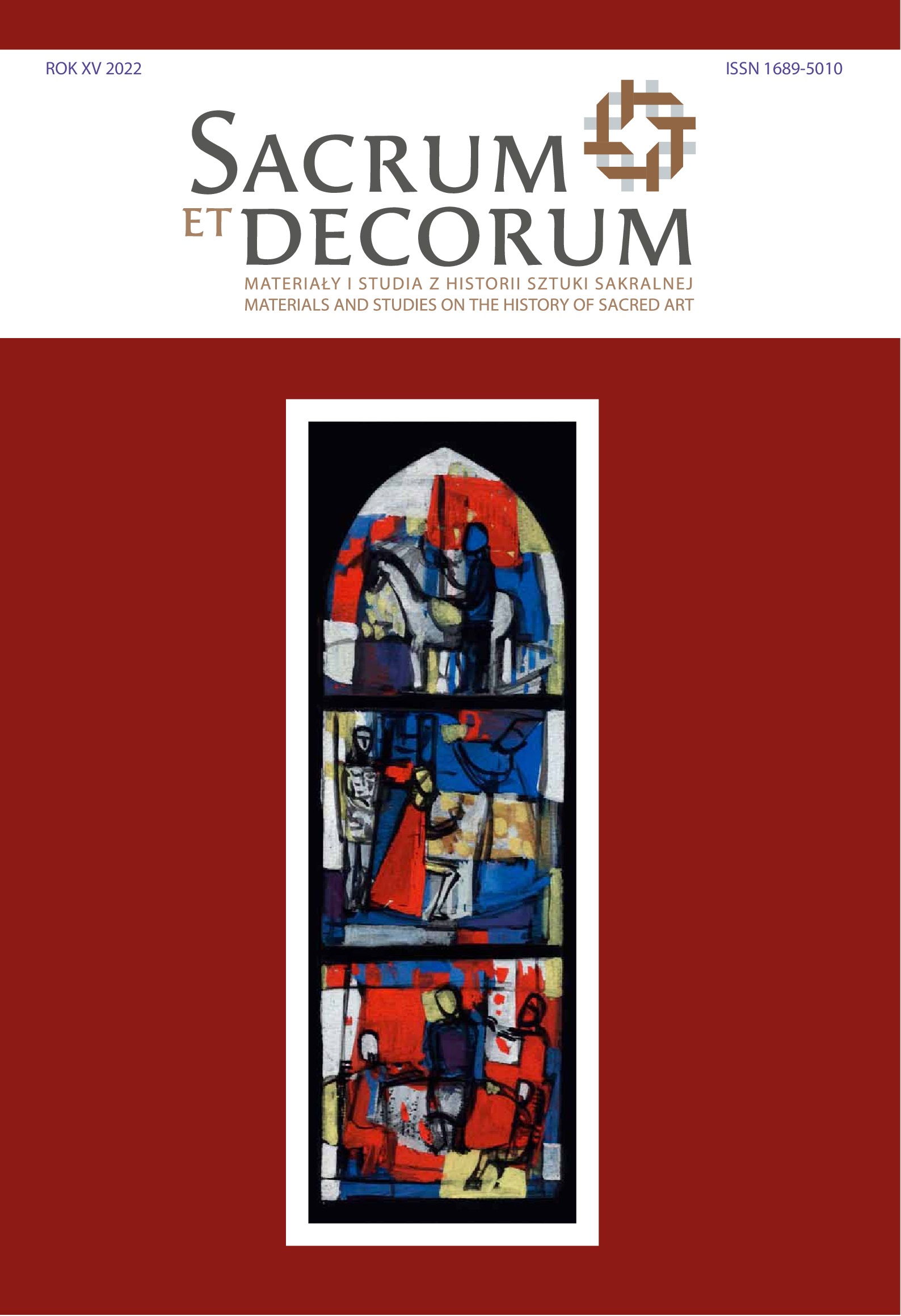The mural paintings of Modest Sosenko. Characteristics of the style based on representative examples.
DOI:
https://doi.org/10.15584/setde.2022.15.5Keywords:
Modest Sosenko, Ukraine, church, murals, early 20th centuryAbstract
In the considerable creative legacy of the Ukrainian artist Modest Sosenko (1875–1920), the murals and sacred easel paintings he created for more than ten Galician churches deserve special attention. His contemporaries noted that the artist’s sacred works were characterised by his own ‘Sosenko style’, which boldly and organically combined Byzantine traditions reinterpreted by 16 th – and 17 th – century masters with modern European stylistic requirements of the turn of the 19 th and 20 th centuries. He was a pioneer who paved the way for the development of modern church art, which was helped by the circumstances of his life. After acquiring a thorough European professional education during his studies in Kraków as well as in Munich and Paris thanks to a scholarship funded by Metropolitan Andrey Sheptytsky, Sosenko returned to Galicia and, continuing his mentor’s activities in the field of museums, became a full-time employee of the Church (later National) Museum. His direct contact with old monuments of iconography, manuscripts and incunabula, and folk art allowed him to gain a deep understanding of the peculiarities of Ukrainian national art. Thus, the combination of his personal talent, professional knowledge and museum experience, as well as his close relationship with the head of the Greek Catholic Church – Andrey Sheptytsky, who directed all his efforts towards the revival of the high culture of decorating the sacred space of Eastern Rite churches, gave birth to an intellectual artist, ready to take up the challenge of the present day. However, it is not possible to appreciate Sosenko’s achievements in their entirety. The warfare in the region during the two world wars of the 20 th century, the years of Soviet rule, which was intolerant of cultural, national and spiritual heritage, and even the first years of Ukrainian independence, were not conducive to the preservation of the churches and their decoration. As a result, researchers are forced to conclude that most of Sosenko’s works have been irretrievably lost. The artist’s sources of inspiration, the specific composition of his monumental artworks, the range of colours, the ideological and aesthetic programme can only be reconstructed on the basis of the decorations of two churches in the Lviv region: St. Michael the Archangel in the village of Pidberizci and the Holy Resurrection in the village of Poliany, by making comparisons with fragments of lost murals recorded in archival photographs, and by adding the decoration, already after restoration toning, of the artist’s last sacred object – St. Nicholas Church in Zolochiv. Even such scattered data make it possible to observe many of the author’s characteristics, to determine the process of the formation of Sosenko’s distinct individual artistic style, to which this study is dedicated.
Downloads
References
Čajkovs’kij K., Arhitektura i štuka malârska a naša rus’ka cerkov, “Dilo” 1893, nr 73, s.1–2.
Čajkovs’kij K., Dlâ čogo religijne malârstvo u nas’ ne podnosit’ sâ?, “Dilo” 1894, nr 226, s. 1.
Holubetc’ M., Modest Sosenko ( 1875–1920), “Hromads’ka dumka”, 1920, nr 32, s. 1–2.
Holubetc’ M., Načerk іstorií ukraíns’kogo mistectva, N’û-Ŭork 1973, s. 34.
Holubetc’ M., Spadŝina Modesta Sosenka, “Ukraíns’ka dumka” 1920, nr 13, s. 2–3.
Kondakov’ H., Licevoj ikonopisnij podlinnik’, t. I: Ikonografiâ Gospoda Boha i Spasitelâ Našeho Iisusa Hrista. S.-Peterburg’ 1905, іl. 73. Obraz devâti činiv anhel’s’kih; іl. 76. Sobor Arhistratiga Mihaila.
Licevoj Sijskij ikonopisnij podlinnik’, СХI, Vip. IІІ. Priloženie k’ СVI vipusku “Pamâtnikov”, S.-Peterburg’ 1896, tаbl. LVI. Ojcostwo.
Licevoj Sijskij ikonopisnij podlinnik’, Vip. ІV. S.-Peterburg’ 1897, tаbl. LXXI. О têbê raduêtsâ.
L’vivs’ka Nacional’na Naukova Biblioteka Ukraíni im. V. Stеfanika (=LNNB), Viddil rukopisiv, F. 191, Fond V. Faciêviča, od. zb. 10, p.1, Žit’êpisi predstavnikiv Stanislavivs’koí kapituli êpiskopa Peleša Ŭliana, mitropolita Kuílovs’kogo Ŭliana і arhipresvitera Faciêviča Vasilâ. 1889–1896. Stanislav [rękopis], ark. 14.
Nacionalʹnij muzej u Lʹvovi (=NML), Viddil rukopisiv i starodrukiv, kv-18592/17-22, rk-3239, Svidoctva M. Sosenka periodu jogo navčannâ u Krakivs’kij školi krasnih mistectv 1897 –1900, аrk. 1–6.
NML, Viddil rukopisiv i starodrukiv, kv-18592/23-27,30, rk-3242, Documenti pro navčannâ M. Sosenka v Akademií mistectv u Mûnheni 1900–1902, ark. 1–7.
NML, Viddil rukopisiv i starodrukiv, kv -18592, rk-3244, Documenti pro perebuvan’â M. Sosenka v Pariżi ta pro navčan’â v Nacional’nij akademií obrazotvorčih mistectv; dozvoli na vidviduvan’â timčasovih vistavok i biblioteki ustanovi, ark. 1–4.
NML, Viddil rukopisiv i starodrukiv, kv-18592/36, rk-3249, Оficijnij list Mitropolita A. Šeptic’kogo do M. Sosenka. L’viv, 3.VII.1907, аrk. 1–2.
NML, Viddil rukopisiv i starodrukiv, kv-18597, rk-2935, Materiali M. Drahana do M. Sosenka, ark. 7–10.
Noga O., Ukraíns’kij stil’ v cerkownomu mistectvi Galičini kincâ ХІХ – počatku ХХ stolit’, L’viv 1999, s. 82.
Otkowič T., Restavraciâ nastinnih rozpisiv Modesta Sosenka v cerkvi Sv. Mikolaja v Zoločevi, w: Bûleten’ 2008, nr 10, s. 133–134.
Prykrasy galickih rukopisiv XVI i XVII vv. zrisovani Modestom Sosenkom ( + 1920). (Iz zbirok Nacional’nogo Muzeû u L’vovi), Lwów, 1923, tabl. X
Radoms’ka W., Povernen’â Modesta Sosenka, Obrazotvorče mistectvo” 1991, nr 1, s. 4–7.
Radoms’ka W., Povernen’â Modesta Sosenka, “Zerna” 1994, nr 1, s. 33–38.
Radoms’ka W., Problema restavratsiï stinopysu Modesta Sosenka v konteksti zberezhennia arkhitekturno-mystets′koï pam’iatky, w: Visnyk Natsional′noho universytetu «L′vivs′ka politekhnika» «Arkhitektura», nr 656: zibrannia naukovykh prats′, red. B.S. Cherkes, Lwów 2009.
Semchyshyn-Huzner O., Onovlen’â vnutrišn’ogo prostoru Katedral’nogo soboru Svâtogo Voskresin’â v Ivano-Frankivs’ku (Stanislavovi) (1897–1904 rr.): istoriâ, аnaliz, perspektivi, “Narodoznavči zošiti” 2016, nr 5, s. 1073–1085.
Šeptic’kij A., Pis’ma-poslan’â (1939-1944 rr), L’viv 1991, s.130–148.
Ustiânovič K., Deŝo o našoj żivopisi čerkovnoj, “Dilo” 1888, nr 7, s.1; nr 9, s. 1; nr 10, s.1–2.
Downloads
Published
How to Cite
Issue
Section
License
Copyright (c) 2022 Sacrum et Decorum

This work is licensed under a Creative Commons Attribution-NonCommercial-NoDerivatives 4.0 International License.
In line with the Open Access policy, authors retain full copyright to their articles – without restrictions.
Authors can deposit their articles in a repository of their choice.


